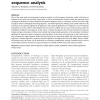Free Online Productivity Tools
i2Speak
i2Symbol
i2OCR
iTex2Img
iWeb2Print
iWeb2Shot
i2Type
iPdf2Split
iPdf2Merge
i2Bopomofo
i2Arabic
i2Style
i2Image
i2PDF
iLatex2Rtf
Sci2ools
BIB
2006
2006
Statistical significance in biological sequence analysis
One of the major goals of computational sequence analysis is to find sequence similarities, which could serve as evidence of structural and functional conservation, as well as of evolutionary relations among the sequences. Since the degree of similarity is usually assessed by the sequence alignment score, it is necessary to know if a score is high enough to indicate a biologically interesting alignment. A powerful approach to defining score cutoffs is based on the evaluation of the statistical significance of alignments. The statistical significance of an alignment score is frequently assessed by its P-value, which is the probability that this score or a higher one can occur simply by chance, given the probabilistic models for the sequences. In this review we discuss the general role of P-value estimation in sequence analysis, and give a description of theoretical methods and computational approaches to the estimation of statistical signifiance for important classes of sequence analys...
| Added | 10 Dec 2010 |
| Updated | 10 Dec 2010 |
| Type | Journal |
| Year | 2006 |
| Where | BIB |
| Authors | Alexander Yu. Mitrophanov, Mark Borodovsky |
Comments (0)

